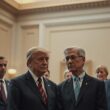The US Bureau of Labor Statistics released data Friday indicating a concerning resurgence in inflation, with the annual rate climbing from 2.9% in August to 3.0% in September. This unexpected uptick, coupled with a monthly price increase of 0.3%, casts a shadow over the Biden administration’s efforts to curb inflationary pressures and potentially influences future Federal Reserve policy.
The core inflation rate, excluding volatile energy and food costs, remained stubbornly at 3.0%, a slight decrease from the previous month’s 3.1%, but still indicating persistent underlying price pressures across the economy. Significant upward contributions came from energy prices, which rose 2.8% year-over-year, a substantial increase from the modest rise seen in August. Food prices, while decelerating slightly, still contributed to the overall inflation figure, increasing 3.1% annually.
Financial markets are closely scrutinizing these figures, keenly aware that a cooling inflation rate could pave the way for the Federal Reserve to initiate interest rate cuts. However, this latest data complicates the picture, potentially delaying any such action and maintaining the restrictive monetary policy that has, until recently, seemed to be demonstrating some success. High interest rates negatively impact both the stock market and the real estate sector, as they make alternative investments, like savings accounts, comparatively more attractive.
Economists are increasingly pointing to the ongoing impact of the Trump-era tariffs as a significant driver of these persistent price increases. Despite pledges to review and potentially adjust trade policies, the legacy of those protectionist measures continues to contribute to inflationary pressures on American consumers and businesses, posing a political challenge for the current administration as they attempt to navigate a complex economic landscape. The persistent inflation represents a potential vulnerability for the administration heading into the upcoming election cycle, highlighting the difficulty of reversing the impacts of previous economic initiatives.





